What is First-Party Data?
First-party data refers to the information that a company collects directly from its own customers or website visitors. This can include data such as names, email addresses, phone numbers, purchase history, website behavior and other interactions with the company.
First-party data is considered valuable because it is typically the most accurate and relevant to the company’s own business objectives. Companies can gain insights into their customers’ preferences, behaviors and interests by collecting and analyzing this data. This information can then be used to personalize marketing campaigns, improve customer experiences and ultimately drive business growth. In this article, we will talk about how first-party data can become a great tool for marketers.
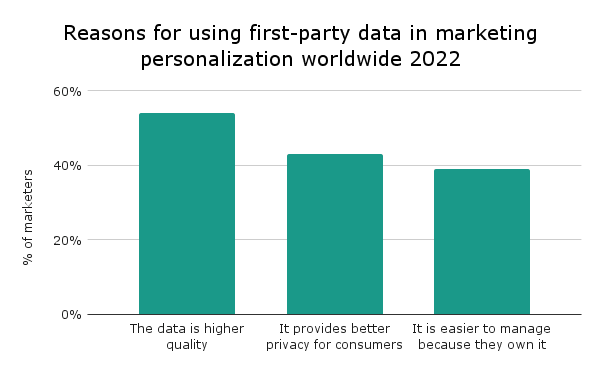
Source: Twilio. (June 16, 2022). Reasons why brands used exclusively first-party data to personalize customer experiences worldwide as of May 2022 [Graph]. In Statista.
1. Different Types of Data
1. First-Party Data
First-party data refers to customer data that is collected and owned by a company through its own software and systems. This data includes digital interactions, purchase history, behavior and preferences.
For instance, a company could analyze a customer’s web or mobile app behavior, in-store or call center interactions, purchase history and loyalty status to create a highly targeted ad or offer that caters specifically to that customer.
2. Second-Party Data
Second-party data is first-party data obtained from a trusted partner. This type of data can help a company achieve a larger scale than using their own first-party data alone. Unlike third-party data, which is typically available for purchase by anyone, second-party data is not sold openly and thus can provide greater value.
For example, a company selling yoga mats might partner with a health food store to obtain data on customers who are interested in wellness and healthy living. This could allow the yoga mat store to offer targeted product recommendations and marketing to customers who are likely to be interested in their products.
3. Third-party data
Third-party data is data that is collected from external sources rather than directly from a company’s customers, in contrast to first-party data. This type of data is often gathered from various sources across the internet and is subsequently compiled, segmented and sold to companies for use in their own advertising efforts.
A real estate agency purchases a list of individuals who recently searched online for homes in a particular area. The agency can use this data to create targeted advertising campaigns, reaching out to these potential customers and offering them relevant services and listings.
2. Why is First-Party Data more powerful?
First-party data is often considered better than third-party data for several reasons.
Companies or brands collect first-party data directly from customers who have interacted their assets. This means that it is more accurate and relevant to the company’s specific needs. This type of data can capture the relationship of a customer with a brand and not just rely on look-alikes. In contrast, companies or brands often collect third-party data from various sources across the web. Ofcourse, this means that it may be less targeted and less relevant to a company’s specific needs. Apart from this, data might also be dated and not as recent or fresh making the insights less accurate.
Second, first-party data is also more valuable because it is unique to your business and cannot be easily replicated or acquired by competitors. This makes it a strategic asset that can help differentiate your brand. More importantly, this can be a competitive advantage in the market. Apart from this, you can also customize the data to be collected to suit the specific needs of your business. For example, do you need more information than just possible interest in a specific product? You can also track how long a customer has stayed on a single product.
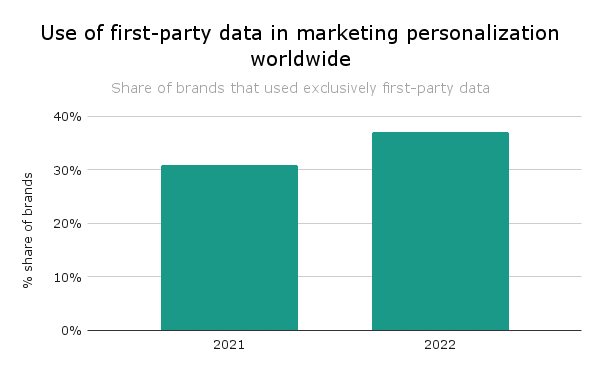
Source: Twilio. (July 15, 2022). Share of brands that used exclusively first-party data to personalize customer experiences worldwide in 2021 and 2022 [Graph]. In Statista.
“first-party data is also more valuable because it is unique to your business and cannot be easily replicated or acquired by competitors”
Lastly, first-party data is often more cost-effective since it is already owned by the company and does not need to be purchased from a third-party vendor. In contrast, third-party data can be expensive to acquire. Because of this, third-party data may not provide a good return on investment. Acquiring third-party data may seem like a quick fix to fill in gaps in your own data. However, it can be expensive and may not provide the same level of accuracy and relevance. Relying too heavily on third-party data can also lead to missed opportunities to engage with your own customers and build deeper relationships with them.
3. Sources of First Data
First-party data comes directly from a brand’s interactions with its customers. It is collected through various touchpoints that consumers use to engage with the brand. These touchpoints can be both online and offline. To fully utilize the benefits, it is crucial to acquire the appropriate data from suitable sources. First-party data can originate from various sources. Below are the probable locations where you can obtain it:
1. Website:
A website can be a rich source of first-party data for businesses. Businesses can gain insights into what content and products are most popular, what pages are visited the most and how long visitors spend on each page by tracking user behavior on their website. This data can help businesses optimize their website design, improve user experience and tailor their marketing strategies to better suit their audience’s interests.
2. Mobile App:
Mobile apps can provide a wealth of data about a user’s behavior, preferences and demographics. For example, businesses can collect data on how often users open the app, what features they use, what products they view and what actions they take, such as adding items to a cart or completing a purchase. This information can help businesses understand their users’ interests and tailor their marketing messages and product offerings accordingly.
3. Email:
Email marketing campaigns can provide insights into which messages are opened, which links are clicked and which products or services are of interest to the customer. This information can be used to tailor future messages and offers to the customer’s preferences. As a result, the likelihood of engagement and conversion can increase.
4. Point of sale:
A POS system is where a transaction takes place. It captures information such as what products were purchased, the date and time of the purchase and the total amount paid. This data can provide valuable insights into customer behavior and preferences. The data can be used to personalize marketing campaigns and promotions.
5. Call centers:
When customers call a business, they provide a wealth of information about their needs, preferences and behaviors. Call center agents can capture this information and use it to build a more comprehensive customer profile.
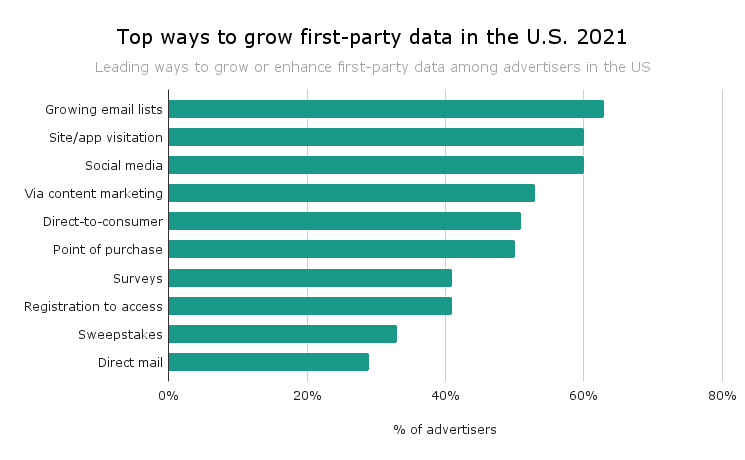
Source: MarketingCharts. (October 4, 2021). Leading ways to grow or enhance first-party data among advertisers in the United States as of September 2021 [Graph]. In Statista.
4. First-Party Data Examples and Use Cases: Google’s Customer Match
Interacting directly with your customers provides valuable insights about their preferences and needs. This first-party data, unique to your business and sourced directly from your customers, is highly valuable. Google’s Customer Match is an advertising tool that leverages this data to help you optimize your marketing efforts. By uploading your first-party customer data to Google and matching it against Google’s user data in a privacy-safe way, you can use Customer Match to deepen existing customer relationships or build new ones across Google’s properties.
The ideal candidates for Customer Match are companies that have multiple touchpoints with customers throughout their customer journeys. These companies can use Customer Match to deliver personalized messages to returning customers and engage with new audience segments based on these high-value customers. This allows companies to optimize their marketing strategies and enhance their customer relationships, making the most of their first-party data.
To illustrate the process of using Customer Match, let’s consider an example where you want to advertise a new loyalty program to your existing customers using Google Marketing Platform. There are several important steps to follow, and the diagram below provides a visual representation of how to create and activate this audience by combining your customer data with Google’s user data.
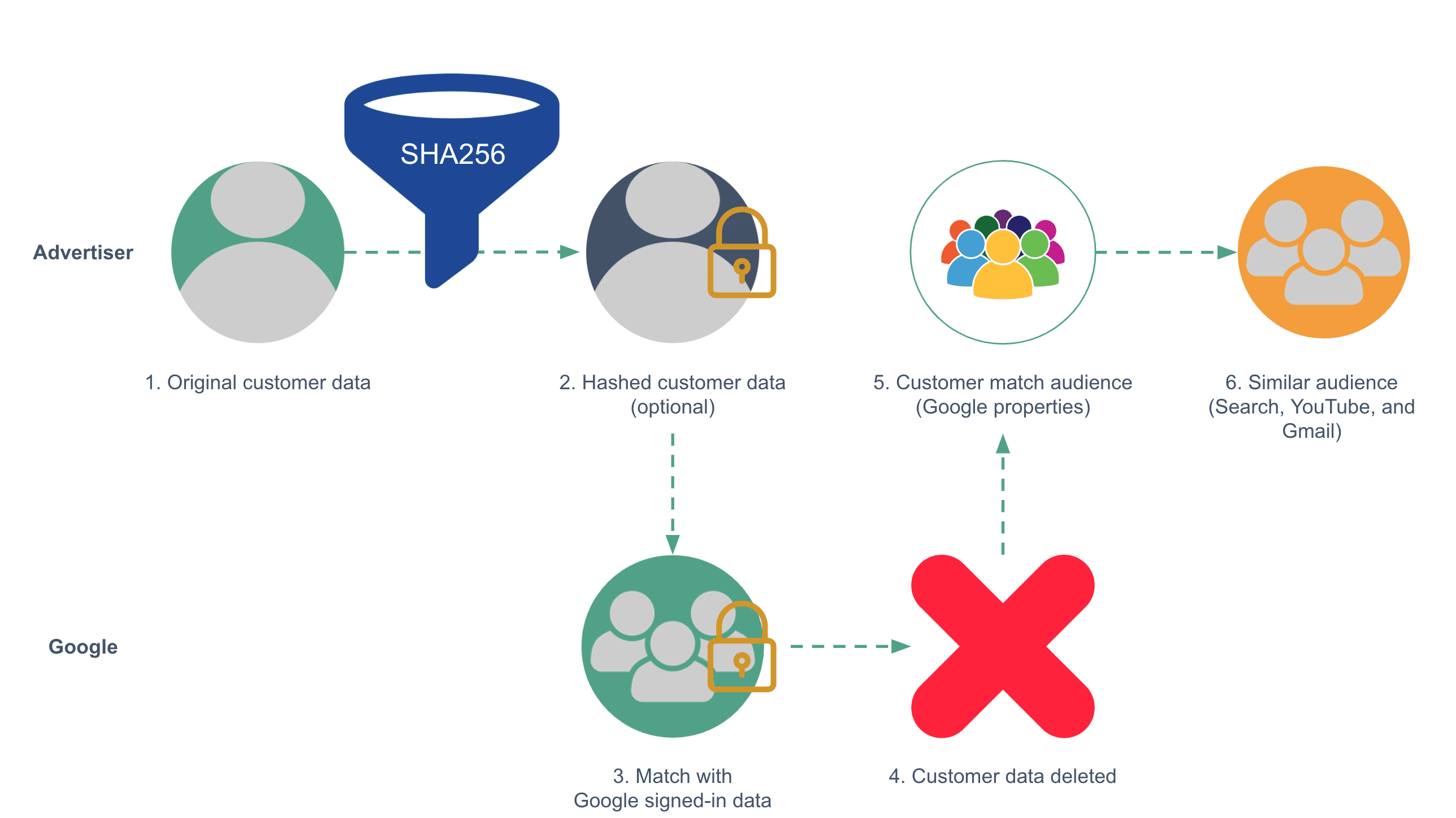
Source: Google. (n.d.). Activate First-Party Data Using Customer Match.
1. Prepare customer data list following the formatting guidelines.
2. Hash customer data before uploading, or Google can hash it for you if uploaded unhashed.
3. Google matches customer data with their user data.
4. After matching, Google deletes customer data.
5. After creating the Customer Match segment, use it for campaign targeting.
6. Utilize matched customer lists and Google’s machine learning to find similar audiences.
5. Activating First-Party Data and Google’s Customer Match
You can utilize Customer Match audience lists at various stages of the customer journey to optimize your advertising strategy. For instance, you use Customer Match to re-engage with your audience or exclude customers who are not actively engaging with your brand. However, it’s important to avoid limiting the potential impact of your audience by solely using your lists for suppression or negative targeting. This approach overlooks the value of the data you possess and prevents you from nurturing your existing customers.
Consider the following the funnel-based targeting approach to fully maximize the value of your first-party data throughout the entire sales funnel.
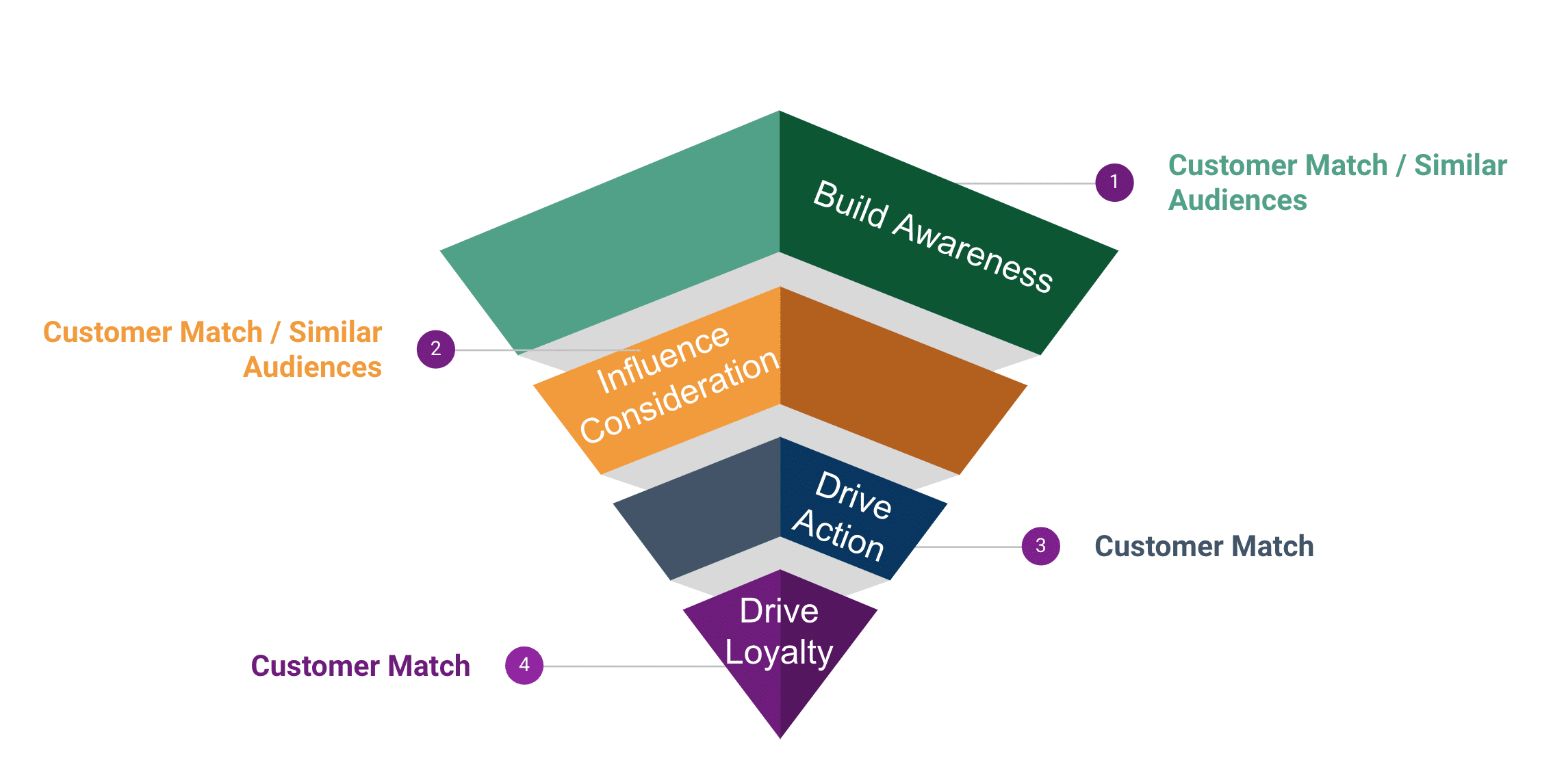
Source: Source: Google. (n.d.). Activate First-Party Data Using Customer Match.
Build Awareness
Conduct an audience profile analysis report to gain a deeper understanding of your current customer base. Utilize these insights to implement specific audience targeting strategies that can help you effectively reach and engage your desired target audience.
The awareness stage focuses on the total reach for your audience. These potential customers who may be interested in purchasing your product in the future, but do not currently have immediate purchase intent. The 2 main targeting strategies when building awareness with customer match are finding similar audiences and excluding similar audiences. First, you can use your audiences to find similar audiences. Alternatively, you can exclude your audiences to avoid overexposure, mixed messages, and wasted media budget.
Influence Consideration
Leverage your Customer Match lists to target Similar Audiences, which are groups of users who share similar characteristics with your existing customers. Extend your reach by including Similar Audiences in your targeting efforts across YouTube, Search, Display, and Gmail.
During the consideration stage, the focus is on audiences that have demonstrated specific interests in your product or service.
Leverage first-party data to gain insights into the behaviors of consumers who have expressed interest or are considering a purchase. By combining this data with Google’s powerful machine learning capabilities, you can identify and target users who are more likely to be interested in your product or service at the right moment. This allows you to introduce your offering to potential customers at the optimal time in their decision-making process, maximizing your chances of converting their interest into a purchase.
Drive Action
Utilize Customer Match lists to target consumers who have shown interest in specific products or have engaged in actions that indicate product interest. This allows you to tailor your messaging and campaigns to reach those who have demonstrated a higher likelihood of being interested in your products or services.
Direct your efforts towards qualified audiences who have expressed interest, such as consumers who have enrolled in a free trial or added items to their online shopping cart.
Utilize your Customer Match lists to engage with these audiences by delivering personalized messages that encourage them to make a purchase. By tailoring your messaging to their specific interests, you can effectively nurture their intent and increase the likelihood of converting them into paying customers.
Drive Loyalty
Leverage Customer Match lists to target your current customers, creating separate lists for your most engaged customers. Utilize modeling techniques to identify customers who are high-value or at risk of churning. This allows you to segment your audience and deliver personalized messaging or campaigns to effectively engage with your existing customer base and optimize your marketing efforts.
The loyalty stage of the customer journey entails nurturing existing customers who make repeat purchases or express interest in other products or services offered by your business.
Leverage Customer Match to combine data from various sources such as your app, website, and offline channels, to create a high-value audience. Target this audience with tailored messages or personalized content when they visit your app or website, enhancing their engagement and loyalty.
In addition, you can also use Customer Match to target lapsed customers or utilize modeling techniques to identify customers who are at risk of churning. By tailoring your messaging to encourage re-engagement, you can effectively retain these valuable customers and strengthen their loyalty to your brand.
Want to learn more about first-party data?
Contact us or follow us on linkedin!
https://www.linkedin.com/company/indaru/
Featured Image by rawpixel.com on Freepik




